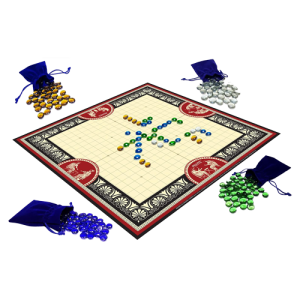I recently interviewed for a Senior Game Product Manager role, and as part of the process, I was given an at-home assignment. I chose to time-box my efforts: ½ day for market research, 1 day to select a game and formulate my answers, and another ½ day to compile a polished PDF report. Although the original ask was to spend about an hour, I was excited to put in more effort so I could adapt it to showcase in my portfolio—a two birds, one stone kind of deal!
The Challenge
Identify a social puzzle game without a modern video game adaptation. Answer the following questions:
- What games would it be competing against?
- What player personas might exist for this game?
- What AARRR features and strategies could it employ to engage and grow its online player base?
- What major risks or challenges exist for this game in achieving product-market fit as a video game?
Result
Game: Pente
Pente is an abstract strategy board game typically played by two players, but it can support up to four players with variations. The goal is to line up five stones in a row (horizontally, vertically, or diagonally) or capture five pairs of your opponent’s stones. It’s simple to learn but offers deep strategic depth.

Digital Pente
A modern makeover of a classic abstract strategy game, presented with a visually appealing style, interactive elements, and audio/visual cues that delight without distracting players. Stones are replaced by customizable models chosen by players. Avatar, backgrounds, boards, player models, animations, and victory effects are cosmetic upgrades earned through long-term play or purchased directly in-game.
Game Modes
Single Player
Play against AI opponents for new player onboarding, solo strategy enthusiasts, or for players practicing strategies and completing challenges.
Local Play
Family, friends, and colleagues can play together.
Online Multiplayer
Play against others in casual or competitive matches.
Game Options
- AI Opponents
- Casual (unranked)
- Competitive (ranked)
- Tournaments (private and public)
- 2-4 player modes
- Versus (two teams of 2 players)
Competing Games
Primary
Strategy puzzle games like Chess, Go, Checkers, and Othello.
Secondary
Games like Catan or Carcassonne that appeal to players who enjoy the strategic depth of territory planning and competing against others.
Player Personas
Strategic Thinkers
Players who enjoy deep tactical planning, similar to Chess and Go.
Social
People who enjoy board games with friends and family, or solo players interested in connecting with others online.
Casual
Players looking for a game that is easy to learn but offers depth that is suitable for short or extended play sessions.
Influencer/Streamer
Content creators who specialize in board and strategy games, who enjoy sharing informative content, live gameplay, and hosting friendly competitions.
Competitive
Individuals driven by leaderboards, tournaments, and mastering the game’s meta.
AARR Features and Strategies
Acquisition
- Free-to-play with in-app purchases for cosmetic items or a low-cost premium model. Market analysis would help determine the optimal strategy.
- Viral marketing through influencers, streamers, and video game reviewers.
- Paid advertising and media campaigns.
- Cross-promotion with strategy and board game communities via platforms like BoardGameGeek.
- Marketing and social media campaigns promoting Early Access and Steam Wishlist.
- Partnerships with services like Xbox Live, PlayStation Plus, to offering free versions or exclusive content.
Activation
- Onboarding tutorials and AI-driven practice modes to introduce new players to the game.
- Accessible matchmaking with casual and ranked modes.
- Cross-platform support for easy access.
- Early access rewards for activation.
- Localized versions in key regions.
Retention
- Game experience is engaging: visual appealing, rewards progression and is fun to play with others.
- Daily and weekly challenges to unlock cosmetic items like avatars, board themes, and player models.
- Seasonal tournaments and special events, such as “Grandmaster” tournaments, with unique holiday-themed content per region.
- Regular updates adding new features (chat support, replay mode, asynchronous play) and game modes.
- Developer engagement through platforms like Steam Community Hub and Discord.
- Brand partnerships with popular franchises like Marvel, Disney, Lego, etc.
Referral
- Players share winning moves/strategies or match replays on social media and gaming communities.
- Incentivize referrals with rewards for both referrers and new players (e.g., discounts or in-game cosmetics).
- Offer limited guest passes for friends in local play without requiring all players to purchase.
- Features that support live-gameplay and tournament coverage via streaming platforms like YouTube or Twitch.
Revenue
- If not free-to-play, generate revenue through initial game purchases.
- Purchasable cosmetic upgrades for game items like boards, models, avatars, etc.
- Offer premium cosmetic sets that are unlocked with long term play, or purchased via special events or promotions.
- Physical merchandise, such as themed boards, available for purchase.
- Leverage Steam discounts: Balance bigger Midweek and Weekend discounts with smaller discounts during saturated seasonal promotion periods to optimize unit sales vs revenue.
Digital Pente offers a unique opportunity to modernize a classic strategy game. With engaging multiplayer features, customizable visuals, and strong community support, it can attract a diverse, global player base.
By focusing on accessible gameplay, strategic depth, and thoughtful monetization, it has the potential to attract both casual and competitive players.
TAKE-AWAYS
1
The initial challenge was choosing a game for this case study! There are already so many puzzle and social games out there based on existing board, dice, or card games.
2
I am happy that I chose to time-box my efforts. This approach was very helpful in avoiding spending too much time focusing on one aspect at the expense of others, including the final presentation. Constraints are indeed healthy, even for small projects.
3
Finding relevant sources for market trends and research can be tricky. While I found reliable information, such as sources like Newzoo, it was time-consuming to summarize and form theories. Given more time, I would like to reference data and trends to show how some ideas were data-informed. In a professional environment, this is where I would partner with a friend from a data/insights team.
4
The employer requested that I brainstorm ideas, which I loved. If I were to iterate on this case study, it would be valuable to narrow down some of the tactics and reflect on how those could be leveraged during each phase of the game’s lifecycle. For example, how early access via Steam has proven successful in recent years for indie and AA games across many phases of the player journey, from initial awareness to activation, retention, and ultimately spending. Similar for regional target audiences and platform preferences.
5
Overall, I thoroughly enjoyed working on this case study. It fed my passion for thinking from the player perspective and connecting that to tangible business needs to create something fun, successful, profitable. I was able to “lose” myself in the process, and time flew by as I frantically wrapped up my edits to the PDF before my self-imposed deadline.
I have an image of this game in my head and have been thinking about how I would design the game’s UX next. Perhaps that will be my next project—design the UX and UI for a Pente prototype!
